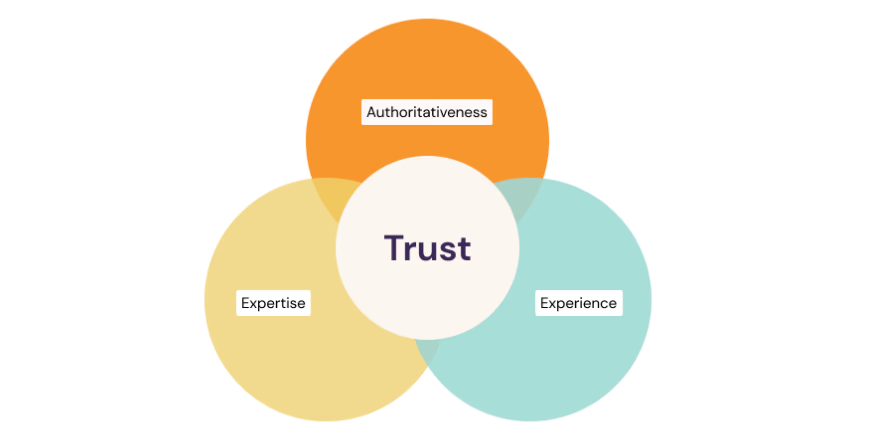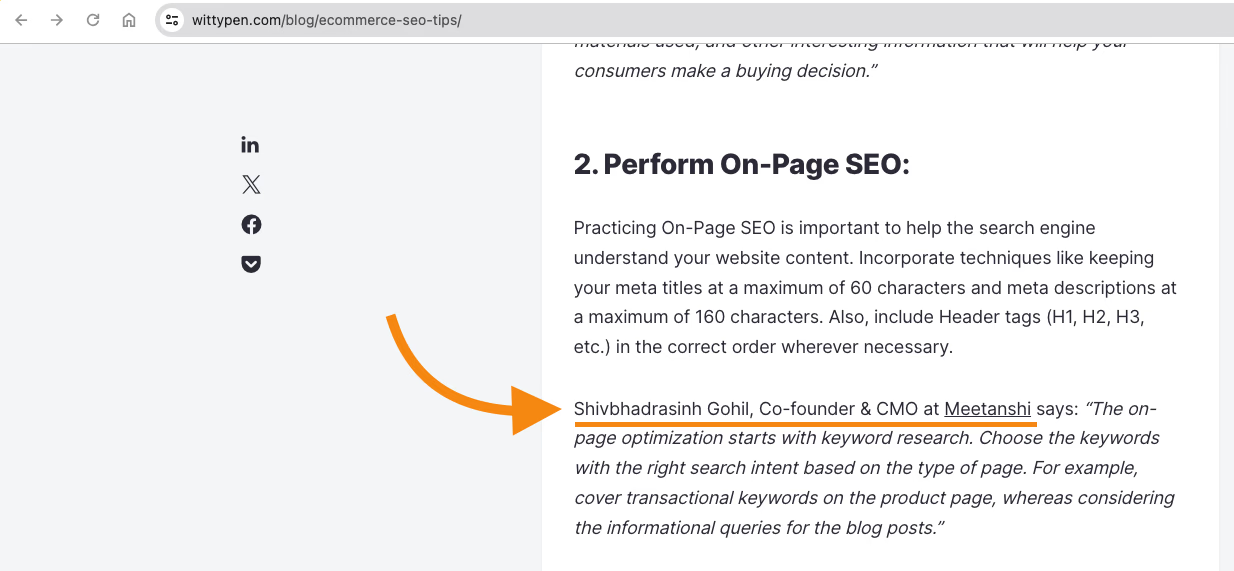Understanding and Optimizing for Google’s E-E-A-T Principles
Ranking on Google Search is no longer as easy as just repeating keywords.
The algorithm has changed a lot over the years. From simple phrase-matching systems to a complex self-learning algorithm, it has evolved to produce the most relevant and helpful results, favoring credible, authentic, and trustworthy results.
Google’s manual review process emphasizes the E-E-A-T principle for page quality rating. Meaning you need to follow Google’s E-E-A-T principle to optimize for SEO.
But what are Google’s E-E-A-T principles? And how do you optimize for them?
In this post, we’ll introduce the E-E-A-T principle for SEO and discuss the strategies to optimize for it.
Let’s get started.
What does Google E-E-A-T stand for?
E-E-A-T stands for Experience, Expertise, Authoritativeness, and Trust.
These guidelines help Google’s algorithm identify accurate, safe, and reliable pages. Basically, these are the criteria of what Google considers “high-quality” content.

Here’s what each element of the E-E-A-T principle means:
- Experience: The content creator has enough first-hand or life experience about the subject matter. (E.g., product review sharing personal experience)
- Expertise: The content creator is qualified or has knowledge enough to talk about the subject matter. (E.g., an article on Covid-19 written by a registered medical professional)
- Authoritativeness: The content creator is a popular go-to source for information in the industry. (E.g., a government website sharing news related to new policies)
- Trust: The most crucial element. Pages that demonstrate experience, expertise, and authoritativeness are considered trustworthy.
Note: Google does not weigh E-E-A-T for all types of pages. The type and amount of trust will depend on the type of page. For e.g., pages that affect the health, financial stability, or safety of people, or the welfare or well-being of society (known as ‘Your Money Your Life’ pages) require high-quality standards.
Initially, in March 2014, Google introduced the E-A-T principle. The extra “E” for Experience was added in the December 2022 revised guidelines that also feature clearer guidance on finding who is responsible for the website or a page’s content, as well as re-defined criteria for determining reputation.
Why is E-E-A-T important for SEO?
The E-E-A-T principle is not a direct Google ranking factor. But following its guidelines can benefit you in the long term.
Here’s why.
Google favors results that are authentic, reliable, and safe for the users. And it keeps improving its ranking process to produce the highest quality and relevant results.
It employs real people, known as search quality raters, to evaluate their ranking systems. And the E-E-A-T principle is at the core of this constant feedback-improvement mechanism.
In other words, Google’s search algorithm is constantly trained to show results showcasing experience, expertise, authority, and trustworthiness. And with each algorithm update, the system is getting better at identifying high-quality results that follow the E-E-A-T guidelines.
How to optimize your website for E-E-A-T SEO?
The detailed Google Search Quality Rater Program Guidelines are publicly available. The document outlines key features of pages that demonstrate each element of the E-E-A-T principle.
Based on that, here are the proven ways to optimize your website for E-E-A-T SEO:
1. Share your personal experience
The first “E” in E-E-A-T stands for experience. It was recently added to Google’s Search Quality Rater Guidelines.
Content that shares first-hand or life experiences is considered more authentic. That’s because expertise and authority are not just enough to prove trustworthiness. Instead, content should offer unique angles and perspectives that are useful to the readers.
For example, a person who has tried a tool can offer better insights than a tech expert who has not. And it’s also something that no AI can replace.
To cover the first “E” of the E-E-A-T concept, publish content that reflects your personal experience or opinion. Good examples include case studies and review articles.
For example, if you’re an SEO service provider, you can publish case studies showcasing how you helped your client succeed. The key here is to show, not just tell.
2. Display who you are
No one wants to read advice from an author with no face and no name. And while the internet is full of such websites, yours should not be one of them.
In the December 2022 revision of Search Quality Rater’s Guidelines, Google emphasized finding “who” is behind the pages and websites. It helps the search quality raters evaluate the overall trustworthiness of the page.
That means you have to add information about your website and its content to establish credibility and reputation.
The “About us” or “About me” page is a good way to add information about your website, its purposes, and the team members. Here are some important information to include:
- Mission or purpose
- Team members
- Contact details like email, phone, etc.
- Physical address, if any
- The site’s social media profiles
If you’re posting blog posts or articles, you can add authors with detailed bios about the author’s expertise, experience, and credentials. You can also add links to the author’s social media profiles and website to make it more credible.
3. Publish authentic & useful content
Google’s E-E-A-T guidelines do not just seek original but also authentic content. It means any factual information on your site should be correct and meet the general consensus set by the experts. And is not misleading the readers.
This kind of factual accuracy is most important for YMYL webpages, like medical articles, stock market-related news, etc.
Ensure that published content is authentic, reliable, honest, and backed by research. Fact-check every important detail and cite data sources.
4. Focus on user experience
In recent years, Google has become a user experience-centric search engine. Meaning it rewards pages that offer superior experiences.
Some important considerations for good user experience include:
- Fast-loading pages
- Simple navigation
- Responsive design
- Easy-to-read and view content
- Site accessible to everyone
Pages that load faster across devices tend to rank better in Google Search Engines.
Optimize your website to offer good user experience to users across devices, especially mobile phones. You can use the Page Experience report in Google Search Console to monitor site performance and optimize it.
On top of that, optimizing other factors like website navigation, layout, and other elements unrelated to the main content can help you improve the user experience.
5. Build social proof
Online reviews and social proof are critical elements of online reputation. In fact, Google’s search quality raters evaluate the reputation of a website and content creators even before they consider the website’s alignment with E-E-A-T.
Reputation is assessed through off-page reviews and ratings. Raters are advised to look for independent reviews, references, articles, recommendations by experts, and other credible information written by people about the website or product.
You can actively encourage your satisfied customers or clients to leave positive reviews on various platforms, including Google My Business, industry-specific review sites, and social media. Displaying these testimonials on your website can significantly boost its perceived reputation.
Also, make sure to proudly showcase any qualifications, certificates, or awards you or your business have earned.
6. Maintain off-page reputation
Google E-E-A-T optimization goes beyond on-page content tweaks. You need to establish off-page signals to establish authority. Even brand mentions, without any links, can help you build a positive reputation.
Here are some ways to do that:
- Collaborate with industry peers
- Take part in expert interviews & roundups
- List your business in relevant online directories
You can use platforms like Help a Reporter Out and Featured to participate in expert interviews and get mentioned.

7. Build (earn) links from authoritative sources
For search engine crawlers, backlinks still separate the high-authority sites from others. Links from other sites act as a vote of confidence. And they can help you establish trust and credibility.
There are multiple ways to build backlinks to your site.
The ever-green method I suggest is to publish high-quality & well-researched content that gets media mentions. (In other words, publish content so good that others keep citing it.)
For example, our article on WhatsApp statistics helped us get 170+ referring domains.
Another effective way is to partner with other site owners and publish guest articles.
Google E-E-A-T principle: The future of SEO
Following the E-E-A-T guidelines means aligning your content with what Google considers “high-quality.” It is a sustainable long-term approach to get ahead in SEO, especially in the post-GPT age, where the internet is flooded with content.
Now, it’s time to take action. Audit your site for weak E-E-A-T areas and optimize it. You can use Nightwatch’s Site Audit feature to quickly monitor and optimize your on-page SEO.
Author Bio: Shivbhadrasinh is the co-founder & chief marketing officer at Meetanshi. He has been in the marketing field since 2010 and has helped 100+ e-commerce sellers with marketing strategy and Shopify SEO Services.
